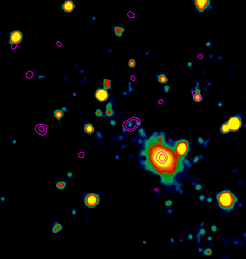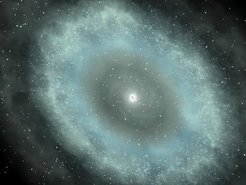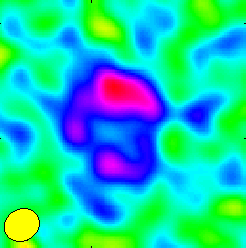Cosmic Magnifying Glass reveals Star Formation at the Edge of the Universe
Observations of star formation in Quasars through successful collaboration of astronomers
Being brighter than a trillion suns, quasars (short for quasistellar objects) are the most luminous objects in the universe, appearing mostly in its early epochs. The energy quasars radiate comes from matter which falls onto a supermassive black hole that grows in the center of these early galaxies. This infalling hot gas radiates brightly, making quasars luminous enough to be seen with large optical telescopes even in the most distant and thus earliest parts of the Universe.

Today astrophysicists are most interested in the heat radiation from quasars. "The thermal radiation from interstellar dust is a strong indication for star formation activity in these quasars," notes Frank Bertoldi from the Max-Planck-Institute for Radioastronomy, who lead the MAMBO observations. "The intensity of the millimeter radio emission indicates that the star formation rate in the quasars we detected is a thousand times higher than in normal galaxies such as our Milky Way." However, a direct proof that star formation is responsible for the dust heating in quasars was lacking until now.
With the help of a "cosmic magnifying glass" the astronomers were now able to obtaint a close look at the inner regions of one of the most distant quasars. The chance alignement of some foreground galaxy with the distant quasar PSS J2322 amplifies and refocuses the quasar light into a lumpy ring shape (Fig. 3). This effect is due to the foreground galaxy's gravity, and was first predicted by Albert Einstein in 1936 as a consequence of his general theory of relativity. According to this theory, light is bend in a gravitational field, and rays which go on different paths appear in different places of the sky. A perfact alingment of the source and the lens produces a ring-shaped image. Einstein thought that such an alignement was highly improbable. The first gravitational lens was however found in 1979, and the first perfect alignement leading to an "Einstein-Ring" was discovered in 1987. With PSS J2322 the most distant Einstein Ring was found, and also the first one seen also in the emission of a molecule, carbon-monoxyd.

"Such strong gravitational lenses are extremely rare," explains Chris Carilli from the National Radio Astronomical Observatory, who conducted the high-resolution observations of PSS J2322 with the Very Large Array in New-Mexico. "Our first observations with MAMBO at the IRAM 30-meter telescope already suggested that this unusually bright object might be lens-amplified. That the lens is perfectly aligned with the quasar now surprised us rather pleasantly."
Because these quasars are very distant, their gas distribution cannot be seen directly. Only the gravitational focusing of the light from PSS J2322 permitted an estimate of the extend of the gas and dust distribution around the black hole. If the gas and dust were very near the black hole, then the lensed image of the optically visible quasar and of the radio dust and molecular emission would look much alike: two point-like sources with an apparent separation of about two arcseconds, which is about one-thousandst of the apparent diameter of the moon.
However, the gas emission appear like a ring, much unlike the optical image. From the size of the ring and its relative position to the optical image, the scientists were able to infer that the gas must extend some 12,000 light years away from the black hole and its surrounding hot gas, which is only light-days in size.

The lensed quasar confirms the groups' earlier conjectures: "We had suspected for some time that lots of stars were forming in the dusty molecular clouds of distant quasars," recalls Dr. Bertoldi. "The lucky discovery of a gravitationally lensed quasar confirms this picture, because at least in this one case, which may well be typical, the black hole cannot heat the dusty gas over their large separation, that imply from its lensed geometry."
"Ten years ago noone would have thought that huge masses of dust and heavy elements already existed so soon after the Big Bang. The heavy elements which constitute the observed dust and carbon-monoxyd are created through nuclear fusion in stars. The original, pristine cosmic matter did not contain any of those elements. Now we know that the very first stars forming in the Universe have very quickly ejected these elements into the interstellar medium, most likely through their strong winds, or through the supernova explosions marking the end of massive stars. This lead to enrichments of heavy elements in the surrounding gas rather similar to what we find today, some 13 billion years later, in the interstellar medium of neighboring galaxies."
The discovery of the Einstein-Ring and of dust emission from the most distant quasars crowns a collaborative research effort of this group of scientists mostly from Germany, France, and the United States. In the past four years they had observed about 150 distant quasars with the MAMBO detector at the IRAM 30-meter telescope, and were able to detect heat radiation from one third of them. The brightest of those were later observed with the Very Large Array, and one of them turned out to be strngly lensed. Many of the targeted quasars were initially discovered in elaborative optical sky surveys by some of the group members: X. Fan and M. Strauss from Princeton University, and G. Djorgovski from the California Institute of Technology. The quasar group further includes P. Cox, A. Beelen, and A. Omont from Paris, R. Zylka, from Grenoble, A. Mahabal from California, and G. Lewis from Sydney.


